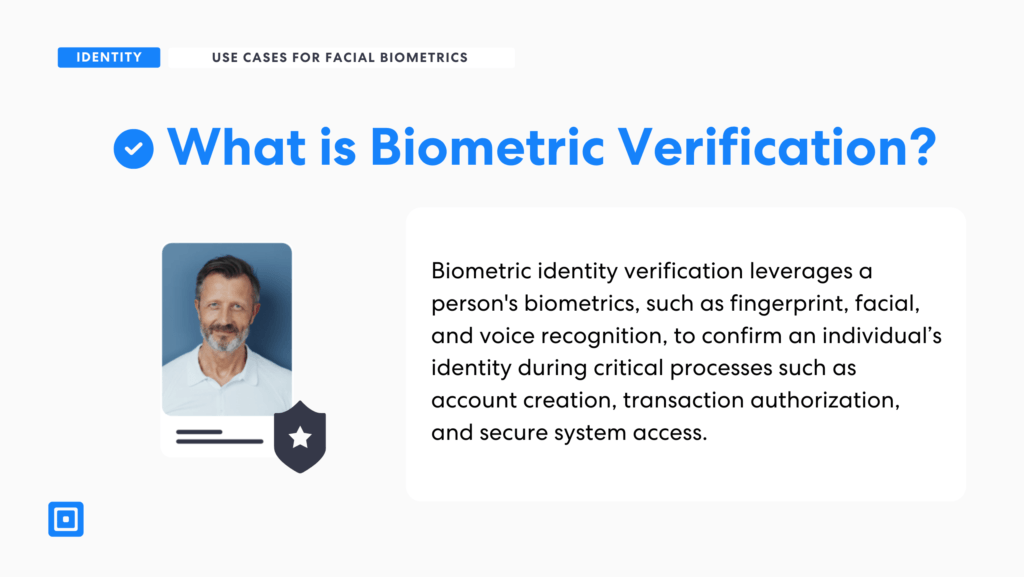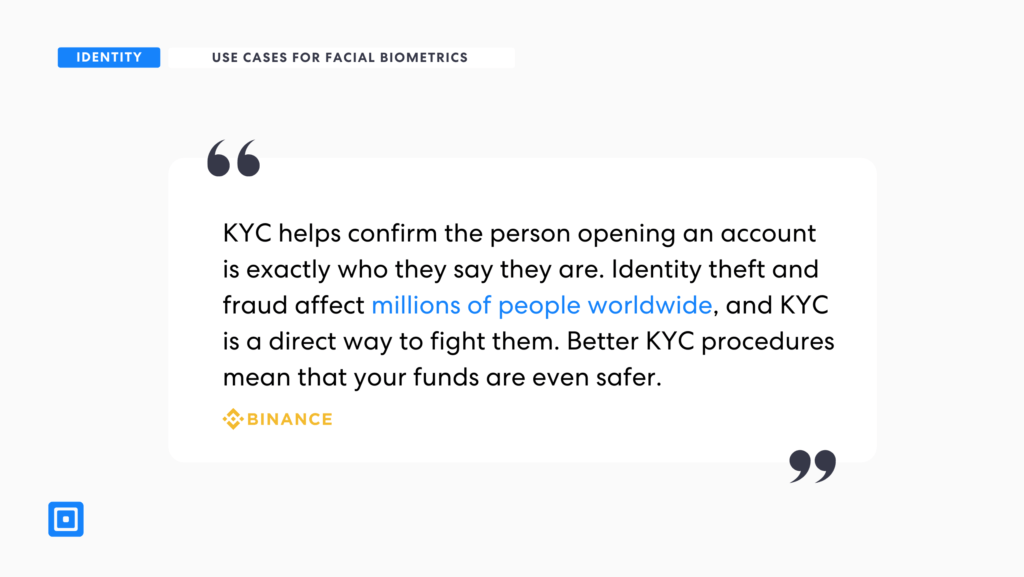Fraud risks are escalating at an alarming rate, with advanced AI technologies like deepfakes posing significant threats across industries. Biometric Identity Verification (IDV) work has never been more critical as businesses face challenges from fraudsters who exploit weak Know Your Customer (KYC) processes to bypass security measures. This article explores the role of a biometric check in mitigating fraud risks and dives into its applications across various industries.
What is Biometric Identity Verification?
Biometric Identity Verification leverages a person’s biometrics, such as fingerprint, facial, and voice recognition, to confirm an individual’s identity during critical processes such as account creation, transaction authorization, and secure system access.
AI and machine learning algorithms play a crucial role in IDV tools. They enhance data processing speed, improve accuracy, and detect fraudulent patterns, making these systems indispensable in combating modern fraud tactics.

One of the standout features of biometric verification systems is liveness detection, which identifies presentation attacks, such as deepfakes or spoofed identities, in real time. This ensures that only genuine individuals can pass through verification, providing businesses with an effective defense against sophisticated fraud attempts. Liveness detection pulls facial biometric data, analyzing subtle micro-expressions, movements, and even skin texture to verify liveness.
How Does Biometric Verification Work?
Biometric IDV involves capturing a user’s unique biometric features—such as facial features, fingerprint scanning, or voice recognition—and comparing them against government-issued identity documentation.
- Biometric Capture: A selfie or video is taken and compared against government-issued IDs. Liveness detection is able to analyze facial biometrics and assure liveness, spotting deepfakes or spoof attempts quickly.
- Verification Result: If the data that is pulled from the selfie or video capture matches that of the government-issued ID, the person gains access. If not, the system flags it for review.
This process ensures that only legitimate, verified individuals can gain access to sensitive systems or resources. Liveness detection and facial biometric analysis ensure that deepfakes and other presentation attacks are identified quickly. For more on liveness detection, read “Liveness Detection: Best Practices for Anti-Spoofing Security.”
Advantages of Biometric Identity Verification Over Traditional Methods
Traditional methods of identity verification, such as passwords or personal questions, have become increasingly vulnerable to fraud. Unlike passwords, biometric verification relies on a person’s unique characteristics, making it significantly harder for fraudsters to bypass security systems.
- Improved Accuracy: Biometrics obtained during verification are far more accurate than knowledge-based authentication methods.
- Convenience: Users no longer need to remember complex passwords or carry physical documents for verification.
- Real-Time Results: Biometric authentication systems offer instant verification, enhancing customer experience and operational efficiency.
This combination of accuracy, convenience, and real-time processing sets biometric technologies apart from other methods. Tools to carry out fraud, such as websites that allow for the creation of deepfakes, are becoming increasingly readily available. Furthermore, an increasing amount of sensitive information is being exchanged on the black market as synthetic profiles are created and traded. Biometric verification is critical to deterring these practices, as well as for achieving national and international compliance.
Sector Use Cases for Biometric Identity Verification
Financial Services and Banking
Biometric identity verification is transforming KYC compliance in financial services. KYC refers to the regulatory standard security procedures that financial institutions must follow to verify the identities of their customers. By ensuring businesses know exactly who their customers are, KYC aims to prevent identity fraud, money laundering, and other financial crimes such as terrorist financing.
Banks and fintech companies use biometric verification to streamline the customer onboarding process. This ensures a secure and efficient identity verification process during account creation, reducing the risk of fraudulent accounts being opened under false identities.
Biometric technologies offer a more secure and reliable way to verify user identities.
Additionally, biometric authentication ensures that only authorized individuals can execute high-value transactions, significantly reducing the chances of fraud in real-time. As highlighted by Brilliance Security Magazine, “Biometric technologies offer a more secure and reliable way to verify user identities. This added layer of security helps prevent fraud and identity theft. It enhances user convenience, especially when integrated into multi-factor authentication (MFA) systems.”
The importance of these technologies becomes even clearer when considering the scale of identity theft. According to a FICO report, nearly 2 million Brits fell victim to identity theft crimes in 2023, underscoring the urgent need for robust KYC processes that incorporate advanced biometric solutions. For more on identity verification within financial services, read “Biometric Verification: Elevating Security in Banking.”
Telecommunications & Online Marketplaces
Telecommunications companies, digital services, and e-commerce platforms face unique challenges in verifying customers, including operational bottlenecks, workflow disruptions, and regulatory compliance issues. Biometric Identity Verification addresses these challenges by securing user accounts during login and payment processes, reducing the risk of unauthorized access.
Telecom companies often deal with large volumes of customer accounts and need to ensure that the right person is accessing or modifying an account (for example, during customer service interactions or account logins). Furthermore, biometrics streamline transactions by removing traditional authentication barriers, such as passwords or security questions, which are often time-consuming and prone to user error. Instead, customers can authenticate themselves instantly using biometric data like facial recognition. According to Stripe, this reduces friction during checkout, eliminates interruptions caused by forgotten credentials, and speeds up the payment process. As a result, it may lead to increased sales and higher customer satisfaction.
For instance, Mastercard has been working towards eliminating manual card entry and passwords by combining tokenization with biometric authentication to create a seamless checkout experience. Similar companies should follow suit to stay competitive and ahead of fraud risk.
Healthcare
Biometric identity verification is crucial for patient safety and data security in healthcare. Misidentification can lead to severe consequences, including incorrect treatments and medication errors. Healthcare providers are increasingly turning to biometric identification checks to ensure accurate patient identification.
For instance, Novant Health implemented iris verification, successfully reducing identity-related mistakes and ensuring patients receive accurate diagnoses and appropriate care. Beyond patient identification, biometric verification strengthens data protection measures. By integrating biometric technologies into their systems, healthcare providers can secure sensitive patient records and comply with privacy regulations such as GDPR.
Cryptocurrency Exchanges
Cryptocurrency platforms are frequent targets of cyberattacks. A notable example is the hacking of FixedFloat in a non-KYC exchange back in February 2024, which resulted in the loss of over $26 million in Bitcoin and Ethereum. Exchanges can prevent unauthorized access during customer onboarding and high-value withdrawals by using biometric verification tools, such as face recognition and fingerprint verification.
KYC helps confirm the person opening an account is exactly who they say they are. Identity theft and fraud affect millions of people worldwide.
As Binance, one of the world’s largest cryptocurrency exchanges, points out: “KYC helps confirm the person opening an account is exactly who they say they are. Identity theft and fraud affect millions of people worldwide, and KYC is a direct way to fight them. Better KYC procedures mean that your funds are even safer.”

Government and Border Security Applications
Border Control and Homeland Security
Government agencies rely heavily on biometric authentication tools for border security and homeland security purposes. Technologies such as iris verification and face recognition are used to quickly and accurately verify a person’s identity at checkpoints. These systems reduce the reliance on identity documents, which can be forged or stolen, and ensure the person presenting an ID is indeed the rightful owner.
National ID Programs
Several countries have implemented biometric identification programs to issue national identity cards linked to biometric data, such as fingerprint scanning and facial recognition. These systems play a critical role in reducing identity fraud, improving security systems, and streamlining verification processes in various public services.
How Leading Solutions Enable Biometric Identity Verification
Tech scams have skyrocketed 400% since 2022, highlighting the need for sophisticated biometric checking solutions to counter equally sophisticated fraud schemes.
Solutions like ComplyCube offers state-of-the-art facial recognition for Biometric Identity Verification, providing businesses with a secure, fast, and frictionless way to authenticate customers. Their platform is designed to meet the evolving needs of modern industries, ensuring both safety and compliance without compromising user experience.
Key Features of IDV Solutions
Advanced Liveness Detection: With ISO 30107-3 and PAD Level 2-certified technology, ComplyCube detects genuine customer presence while safeguarding against advanced spoofing techniques like face recognition and 3D masks. This ensures that the individual presenting an identity document is the same person in real-time.
Expert Document Check: ComplyCube’s document verification supports over 13,000 types of documents, ensuring that all identities can be securely verified.
Protect your business with a trusted partner – contact a compliance expert at ComplyCube today to explore how their biometric verification solutions can safeguard your business from identity fraud.




